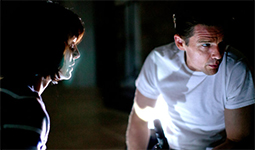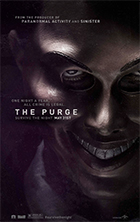The Purge
|  James DeMonaco’s The Purge has a great short-story concept, the kind that would fuel a nice 10- to 12-page shocker in which we observe what we think is an ordinary day only to slowly discover that there is something horrible about to take place (think Shirley Jackson’s “The Lottery”). Because DeMonaco is writing and directing a feature film, he has to move beyond those confines, so instead of gradually revealing what the purge of the title is, he simply informs us in the opening minutes: In the very near future (2022, to be exact), the United States has not only recovered from an economic slump, but flourished and reduced crime and unemployment to almost nothing by allowing a single, purgative night of unpunished crime. The idea is that all the animosity, hostility, and desire for vengeance that are restrained for 364 days a year can be cathartically released over a 12-hour period—an annual unleashing of the human beast. James DeMonaco’s The Purge has a great short-story concept, the kind that would fuel a nice 10- to 12-page shocker in which we observe what we think is an ordinary day only to slowly discover that there is something horrible about to take place (think Shirley Jackson’s “The Lottery”). Because DeMonaco is writing and directing a feature film, he has to move beyond those confines, so instead of gradually revealing what the purge of the title is, he simply informs us in the opening minutes: In the very near future (2022, to be exact), the United States has not only recovered from an economic slump, but flourished and reduced crime and unemployment to almost nothing by allowing a single, purgative night of unpunished crime. The idea is that all the animosity, hostility, and desire for vengeance that are restrained for 364 days a year can be cathartically released over a 12-hour period—an annual unleashing of the human beast.It’s a startling idea—one that, if you think about it too much, is pretty much untenable, but on first glance carries a powerful philosophical charge given that it rests on the unsettling notion that human violence is inherent and therefore must be indulged in some way at some time (in this respect, it has much thematically in common with A Clockwork Orange, which suggested the futility and even immorality of eradicating violence). DeMonaco rightly recognizes that, regardless of how far humanity advances in terms of civilization and technology, the animal within is still restless, so the question is not whether that animal can be eradicated (as H.G. Wells envisioned in his utopian speculative histories of the early 20th century), but rather how to deal with it. Can society thrive best if human violence is simply better managed, in this case by corralling and indulging it without constraint one night a year? Unfortunately, DeMonaco ultimately has to do something with this intriguing idea, and he decides to isolate the issues in the lavish McMansion of the Sandin family, whose white-collar patriarch James (Ethan Hawke) has made a small fortune selling elaborate home security system to his wealthy (and envious) neighbors to protect them from the Purge’s violence, lest it creep out of the inner cities and invade their posh, gated neighborhood in the hills. The Sandins are an entirely ordinary upper-class family: James’s wife Mary (Lena Headey) is a stay-at-home mom who looks after their 16-year-old daughter Zoey (Adelaide Kane) and preteen son Charlie (Max Burkholder). They wear their economic privilege without much thought, except that one night of the year when they lower steel shades over all the house’s doors and windows, turning it into a kind of mini-fortress that only the wealthy can afford—a throwback, in its way, to the Dark Ages. The idea that the economic and social consequences of the Purge—that the elderly, the poor, and the disabled, the ones who are least able to defend themselves on a night when violence goes unpunished, are most likely to be killed off—are not just a side effect, but perhaps its fundamental reason for being, is aired in the background via radio and television shows in which talking heads debate the Purge’s pros and cons just as they would a new tax incentive or welfare program. The Purge, which has been going on for at least a few years now, is thus rendered banal, just another national holiday that must be dealt with, albeit with guns and security systems. The Sandins’ plan to hunker down in their fortified McMansion is upended when Charlie, ever the oversensitive kid, decides to let in a wounded man who he sees via their security cameras crying for help in the street. The man (Edwin Hodge), whose name is never uttered, yet appears to be a homeless veteran, is most likely dangerous, at least in the sense of a wounded animal who will defend itself at all costs. He may not be out looking for blood, but he may be willing to hurt and kill if it means protecting his own life. Unfortunately for the Sandins, this man was in the process of being hunted by a particularly ruthless gang of young killers who knock on their door and demand that he be sent out for them to finish the job or else. The problem is that the man is hiding somewhere in their vast house, recently made even larger by an addition funded by James’s increased security sales. The gang outside, most of whom are hidden by creepy caricature masks, is led by a young man (Rhys Wakefield) whose crested prep school jacket and refined diction mark him as a similarly privileged member of the wealthy elite. However, unlike James and his family, this young man fully believes that his social status gives him special license during the Purge to kill those beneath him; he has fully internalized the Marquis de Sade’s contention that royalty have the divine right to murder (although this young man’s brand of royalty, being American, is vested in economics, rather than blood lines). What this all amounts to is an elaboration of the familiar home invasion narrative, as James and his family are forced to resort to the violence they otherwise refuse to engage during the Purge (although they still sanction it as a necessary social program, if one could call it that). DeMonaco, a writer who is developing into a skillful enough director (this is his second directorial effort, following 2009’s intersecting-lives drama Little New York), clearly intends for the narrative to carry dire social and psychological implications, but the manner in which it unfolds never allows for anything to penetrate much beneath the surface. Unlike, for example, Sam Peckinpah’s masterful Straw Dogs (1971), DeMonaco doesn’t spend enough time with the characters pre-Purge to give us much insight beyond the bare necessities, so their eventual devolution into primordial self-protection feels more like genre machinations than psychological intrigue. All of the actors perform their duties admirably, with Hawke being particularly effective in conveying James’s sweaty, nervous back-and-forth between protecting his family and answering to a higher morality. On the other end of the moral spectrum, Australian actor Rhys Wakefield has a particularly nasty way of smiling that suggests a deep-seated sadism that transcends simple criminality, but his character is ultimately a scary cartoon. Had DeMonaco found a way to engage the ideas inherent to his premise rather than simply exploit them for dark-of-the-house thrills and surprises, The Purge might have been something truly chilling. Copyright ©2013 James Kendrick Thoughts? E-mail James Kendrick All images copyright © Universal Pictures |
Overall Rating: 

 (2.5)
(2.5)


